Feeling as if your content has the lifespan of a mayfly?
That’s probably because you hop on never-lasting trendy waves that subside in one to three days. You do it more often than you produce evergreen content with its interminable potential, whether for content marketing as a company or blogging as a personal brand.
But it should be vice versa. Let’s recall the golden rule: 80% of evergreen + 20% of timely content.
So, it’s time to learn how to write evergreen content that withstands the tides of change (and the whims of Google’s algorithms!).
Examples of Evergreen Content
What is evergreen content?
When we say “evergreen” about any content (text, image, video, audio), we mean that it preserves freshness and relevance for an immeasurably long period. It should deliver the same value to the reader as it did five, ten, or even 20 years before.
Look at the following evergreen content ideas with real-life examples:
- Glossary or knowledge base: Our Knowledge Base of Web3 Insights
- Checklist: Employee Onboarding Checklist
- How-to guide: How to Crochet in Easy Steps
- X-list: 10 Design Hacks for Non-Designers or 28 Proven Ways to Save Money
- Template: Job-Winning Resume Templates
- Do-it-yourself tutorial: How to Make a Handmade Greeting Card
- FAQ section: What Is Blockchain or How Does Insurance Work?
For brands particularly, Simon Healy, Director at Wardrobe Warehouse, outlines a critical type of evergreen content: user-generated content, aka UGC. He puts it metaphorically, “UGC pieces, such as a customer story, a video testimonial, or a case study, never go out of content fashion. UGC is ‘the little black dress’ of your content strategy. It is always relevant and always in style on any channel: a blog, social platform, email, or others.”
Wardrobe Warehouse uses customer testimonials for evergreen content strategies across various marketing channels. For example, their website’s homepage features a carousel of Google reviews.
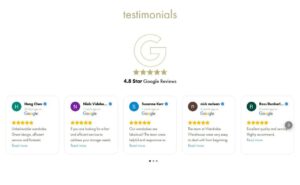
How to Write Evergreen Content That Lasts Through the Ages
To create evergreen content, focus on crafting timeless content that is comprehensive and engaging. Evergreen content performs better over time because it addresses universal questions or problems, unlike seasonal or trending content. This type of content has the potential to remain relevant for a long period, consistently driving traffic to your website. By using evergreen topics with high search volume, you can create long-lasting content that stands the test of time.
Making your content evergreen means aligning it with your content calendar and ensuring it stays relevant content. Update your content to reflect new insights and trends while maintaining its core value. Evergreen content tends to perform steadily and brings significant benefits of evergreen content, such as driving consistent traffic to your site. Make sure your evergreen content is designed to appeal to your target audience with engaging content that resonates.
To maximize the performance of evergreen content, share your content widely and optimize it for search engines. Great content that is comprehensive and tailored to your audience can rank higher in search results and attract traffic to your site. Viral content may have short-lived success, but content that stands the test of time will continue to deliver value. By focusing on creating evergreen content, you ensure your content marketing strategy builds a foundation of reliable, timeless resources.
Prioritize timeless over trendy topics.
Chasing the hottest themes may feel like running on a hamster wheel—exhausting and, let’s admit it, rather dizzying. Besides, hype-driven trends vanish like shooting stars, replaced by newly emerged ones.
In this context, focus more on the so-called “immortal” topics as the North Star of your evergreen content strategy. Evergreen articles or posts built around evergreen topics not only remain relevant but also drive consistent organic traffic over time. By targeting keywords with significant search volume and conducting thorough keyword research, you can create content that serves as a long-term asset in your content marketing efforts. To keep your content fresh and impactful, update your content regularly and refresh older pieces to align with best practices. This approach not only strengthens backlinks but also ensures your articles maintain their position in search engine rankings.
But what about seasonal topics? Are they evergreen, or are they not?
To hear some tell it, seasonality-bound content can’t be evergreen. However, Julia Doak, Franchisor at Bedpost, argues that it actually is since it circles back year-to-year like clockwork. “Every year, we traditionally notice a segment of web visitors scrolling blog articles through holidays and looking for seasonal bedding or sleeping tips. That’s why we never discard seasonality and create evergreen content for a specific season.”
For example:
The Bedpost team offers articles like “Tips to Help Children Sleep Over Summer” or “Best Beds for Holiday Homes and Rentals” to their blog audiences within sniffing distance of summer holidays.

Ditch year markers in favor of timeless words (for titles).
As soon as you drop the year (say, 2025) into your title, your content’s clock starts ticking.
So, opt for dateless or, more accurately, “yearless” titles.
Let’s assume that you want to write a travel blog post. Rather than going with “X Free Travel Tips for 2025,” create evergreen content titled “How to Travel for Free.” Pro trick: You can add the year to the meta title of your article and then change it every year for SEO.
As an alternative, turn to ageless words.
With experience in writing evergreen guides on LLC business law for the corporate blog, Jonathan Feniak, General Counsel at LLC Attorney, shares a list of those:
- Ultimate
- Everyday
- Universal
- Practical
- Common, etc.
Here are several examples from the LLC Attorney’s blog: “The Ultimate Guide to LLC Formation” or “Common LLC Myths & Misconceptions.”
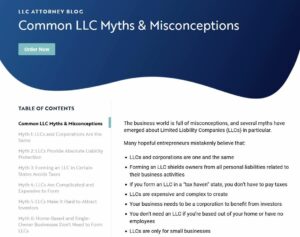
Feniak also warns, “If you do use year indicators in your blog post titles, update those numbers periodically. Anyway, a regular article polish will be beneficial for the content’s longevity.”
Spice it up with evergreen keywords.
Why do you need keywords?
Exactly. They are necessary for SEO-optimized content writing and ranking higher on Google.
But the task is trickier than you think because you must keep a healthy balance of evergreen SEO keywords. Treat keywords like spices for a dish. Use enough to make evergreen content rank better in the search results, but don’t “over-spice” it for SEO.
“You should write for people first,” claims Stanislav Khilobochenko, VP of Customer Services at Clario. “Your audience wants engaging and helpful info, not robotic-sounding texts. When creating evergreen content, never overstuff it with keywords. Add them in moderation to optimize yet bring meaning and value. Ideally, stick to the keyword density of approximately 2%.”
For example:
In the article, “How to Stop Someone from Spying on Your Phone,” the Clario team uses evergreen keywords as follows: “protect your phone from spyware,” “anti-spy protection,” and others.

Pro tip: Use Google Trends to track how the keyword’s popularity changes with time.
Suppose you need to write evergreen content on the cybersecurity topic. Take several keywords and compare them by “Interest over time,” as in the screenshot below.
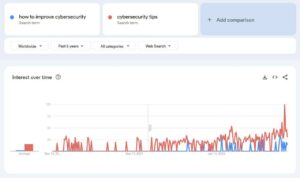
Translate and localize it for international markets.
Picture the following.
You’ve crafted a perfect evergreen piece—content that’s insightful, useful, and remains relevant to your business no matter the year. This guide to evergreen content is designed to drive traffic and rank higher in search results by aligning with the search intent of your target audience. But what if this masterpiece lands in front of global audiences speaking different languages? They neither understand your text nor get your joke or idiom, even when translated into their language. To make your content truly universal, focus on creating content for search engines while ensuring it connects with the target audience. Keep your content adaptable and timeless, incorporating evergreen keywords and examples of evergreen content as part of your content marketing strategy. This will ensure consistent traffic, greater social shares, and a piece of content that remains relevant across borders.
“While translation conserves the meaning, localization guarantees cultural acceptance of your evergreen content,” claims Chris Aubeeluck, Head of Sales and Marketing at Osbornes Law.
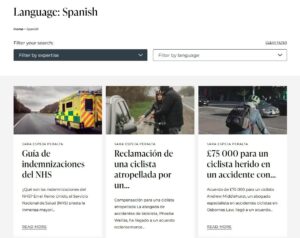
It’s like giving it a universal, internationally valid passport. Need to engage English-speaking readers? Ta-da! Want to convert leads into customers in France? Voilà!
Aubeeluck says their marketers always turn to translation and localization when writing evergreen content for multilingual clients on the website. “From law guides to legal cases, we translate and localize content into more than five languages to equally target every market segment.”
For example: Here’s a bunch of legal case studies translated from English to Spanish by Osbornes Law.

Design ageless visuals.
What about visual aesthetics?
While creating evergreen content with timeless kitchen designs, Greg Arnold, General Manager at Kitchen Mania, says, “It’s better to avoid visuals linked to in-vogue topics or trending phenomena. Trendy memes, videos, or GIFs might be just in time for today but absolutely inappropriate for tomorrow.”
He suggests adhering to these principles to maintain the aesthetic magnetism of your visual content through decades:
- Simplistic typography
- Skimmable text layout in short blocks
- Minimalistic imagery (consider AI-generated images or photos)
- Neutral, balanced colors (typically, classic color palettes like whites, grays, soft greens or blues, and earthy tones never go out of style)
- Responsive and adaptive UI/UX design for desktop and mobile devices
For example:
The Kitchen Mania team prefers laconic color schemes when featuring timeless kitchen designs and sharing expert advice on the company’s blog.
In case you’d like to highlight your brand essence, Arnold notes, “For content branding, make your brand identifiers recognizable yet place them subtly in the corner of your video or image not to overflow visual content.”
We’ve talked a lot about blogs.
Now, let’s shift the spotlight to evergreen content creation for social media in particular.
Incorporate valuable and always-shareable pieces like these into your social media strategy:
- The greatest mistakes/lessons
- Do’s and don’ts
- Step-by-step instructions
- Lists and checklists
- Motivational quotes
- Myths vs. facts
- Case studies and testimonials from satisfied customers
Michael Nemeroff, Co-founder & CEO at RushOrderTees, cautions that such evergreen content pieces may get buried under piles of other posts and lost with time if not categorized. “Group your evergreen social media posts into thematic categories or blocks. Categorization makes it discoverable and accessible to your future audiences. But there’s more—it clears up the mess in your social media accounts.”
For example: On Instagram, RushOrderTees collected evergreen content into several groups, including FAQs (“How Do You Place a Custom Design onto a T-Shirt?”) and Articles (“How to Easily Wash Your Favorite Hat without Ruining the Shape”).
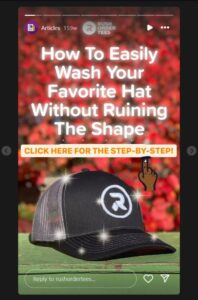
You can likewise do it on TikTok (Playlists), Pinterest (Boards), or any other social channel that allows content categorization.
Expect questions readers haven’t asked yet.
What will the future reader ask? What content will they search for?
In the words of John Grant, Founder & CEO at Premier Bidets, “You don’t need to have a futuristic mindset to predict the curiosity of tomorrow’s readers. Simply track what content gains popularity gradually, not abruptly in spikes, and monitor what your social media audiences bookmark and save for consulting later.”
Peeking into the next era, Premier Bidets joined the worldwide movement for sustainability and environmental awareness, which is projected to last for decades at minimum. They prepare answers to unasked questions.
For example:
Look at this Instagram post with eye-opening facts about water consumption in the toilet paper industry compared to bidets.

Indeed, since climate change and other ecological issues have awakened the globe, the popularity of searches for sustainable goods and services has increased by 71% in the past five years and continues to grow.
Other light-years-ahead topics may be:
- Blockchain and cryptocurrency
- Quantum computing
- People’s lifespan and aging
- Genetic engineering
- Next-gen food systems
- Human-machine integration
Just a small note: Remember to add relevant hashtags to your evergreen content on social media.
For instance, your sustainability-driven posts may have hashtags like #ecofriendlyliving, #earthfriendly, #green, #environmentallyconscious, etc.
Create Evergreen Content with Writecream’s AI
Why struggle solo when AI has got you covered?
Let your fingers take a rest from typing—the AI content generator is here!
Start for free and join 1.5 million companies that firmly step into the future of content creation. With Writecream, you can save hours daily on generating evergreen content. Try and count yourself!
The Key to Continuous Traffic
In conclusion, focus on creating evergreen post content types that add value to your audience and remain relevant for a long period. Learn how to create search-optimized content by finding evergreen topics and offering tips for writing content that helps your readers solve problems or gain insights. A well-crafted evergreen blog not only drives traffic to your site but also attracts new customers by delivering content still valuable over time. Examples of this could include how-to guides, FAQs, or tips for writing content that’s both engaging and informative. Use internal linking to enhance navigation and ensure your content writer adds evergreen elements to keep it impactful. By consistently adding new, evergreen content, you’ll build a library of content to help your audience while strengthening your online presence.


